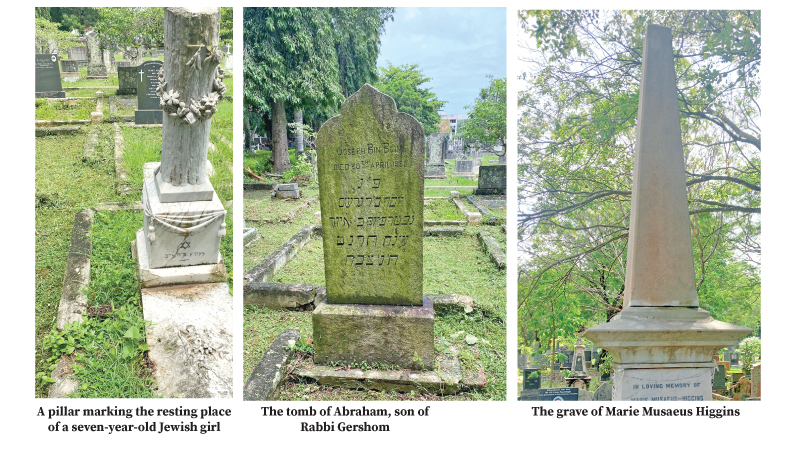The history of Jews in Sri Lanka had fascinated me for quite some time. Despite the elusive nature of the topic, the Jews do have some lore with the island that had been covered time and again. However, I decided to take a different approach.
Tombs, tombstones, graves, cemeteries and mausoleums are packed with history. Archaeologists owe it to gravesites for the significant amount of our understanding of ancient people. They say dead men tell no tales, but the bones of Neanderthals and Egyptian mummies have helped decipher our past just as good as any written records, tools and monuments have.
Borella cemetery
My search started in Sri Lanka’s biggest and well-known necropolis – the Kannatte Cemetery in Borella. Borella is so famous for its cemetery, that the name of the Colombo suburb itself is used interchangeably to refer to Kannatte. With a size of 19.3 hectares and over 120,000 graves (and counting), a search for a few graves could be daunting to say the least.

A Jewish visitor places a rock on the grave as a mark of respect
Questioning the orderlies at Kannatte, I soon encountered a slight hiccup. I asked them in Sinhala where I can find the ‘Yudew’ (Jewish) graves and they pointed in the direction of the Commonwealth War Graves.
The Sinhala word for war (Yudda) and Jew (Yudew) are homophones. Deciding not add more to the confusion, I moved on to look for the graves on my own.
Two particular graves I was looking for have been featured in local and international articles and I found them a little ways up in the Christian section; just a few paces from the guitar-emblazoned headstone of popular songster Clarence Wijeywardena.
There were two; a tablet and a pillar, quite out of place from the crosses surrounding them.
According to a blog post by a Jewish travel writer, Yakov Moar, the pillar marks the resting place of a seven-year-old Jewish girl and the tablet of Abraham, son of Rabbi Gershom. The tablet’s inscription marks his passing in 1898 and his father’s rabbinical role in Colombo.
There is one other grave that had eluded travel writers. Nestled away under acacia trees in the South side of the Christian section, you find a granite stone with faded Hebrew letters. You can make out the English inscription which says that the deceased was one ‘Lena the wife of Max Rosenberg’ who passed away on November 26, 1909.
Soldiers
The Commonwealth War Graves in Kanatte, Jawatte and Kandy also revealed a number of Jewish graves. These belong to Jewish soldiers who fought in the British forces on the Eastern Front of World War II.
The Commonwealth War Graves in Borella is the resting place of two Jewish soldiers. One Eliaz Ezekiel – a Sapper in the Indian Engineer Corps and Private L. Kasolofsky of the Devonshire Regiment. I chanced to meet an Israeli visitor praying at one of the graves. He said that Ezekiel was a Sephardic Jew – the Jewish community of the Iberian Peninsula and Kasolofsky was an Ashkenazi Jew – the Jewish Diaspora of Europe. The visitor placed a rock on the Sapper’s grave and explained that this was a mark of respect among the Jews.
As Eliaz’ grave indicated that he served in the Indian Engineer Corps, I wondered if he was in fact a Paradesi Jew, as the Sephardim in India were commonly called; distinct to their more native brethren; the Cochin Jews of Kerala and Bene Israel of Mumbai.
I noticed the Hebrew abbreviation etched in the middle of the Stars of David: Tav, Nun, Tzadik, Bet, Heh; read from right to left. “It means, t’hay nafsho tzrurah b’tzror hachaim,” the visitor clarified, meaning “May his soul be bound up in the bond of life.” This is a quote from I Samuel 25:29 from the Hebrew Bible and is basically the same as ‘May he attain the Supreme Bliss of Nibbana’ for Buddhists and RIP – ‘Rest in Peace’ for Christians.
Jawatta Cemetery has one lone Jewish soldier, buried alongside his Buddhist, Hindu, Christian and Muslim comrades. Private M. Manis was his name and he was part of the East Surrey Regiment.
The other one is found in Kandy. Also a lone Jew among Gentiles, the soldier was an Aircraftman in the RAF named H.I. Rosenfield.
Suddu Amma
The legendary educator Marie Musaeus Higgins, founder of Musaeus College, Colombo was a Jew who converted to Buddhism. The Jewish identity and faith are tied together. Jews have converted (and reverted) down history. Another Jew of renown in Sri Lanka, the Ven. Nynaponika Mahthera (born Siegmund Feniger) introduced himself as a Jew who converted to Buddhism in his correspondence with Israel’s first Prime Minister, Ben Gurion. There is also a belief among the Jews that the nefesh (soul) of a Jew never changes even if they convert to another religion.
And so I decided to track down Musaeus’ grave in Kanatte, deciding that she must be included in this article. Known endearingly as Suddu Amma (Fair Mother) by Musaeuites, her resting place is marked by a beautiful granite obelisk at the very border where the Buddhist section met the Christian one. Her grave was a modest Buddhist one, like the ones around her. No Hebrew inscriptions here to indicate her nativity.
With a breath of relief I close my account on the Jewish gravestones, but I wonder where I can go next? During this search, I also encountered a Japanese Cemetery in Borella Kanatte with beautiful Kanji inscriptions. Perhaps, there are more Jewish tombstones to be found? All in all, I believe my venture was fruitful.







